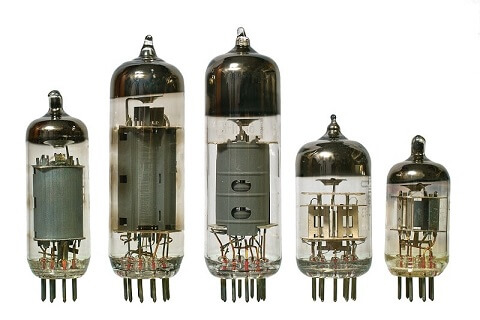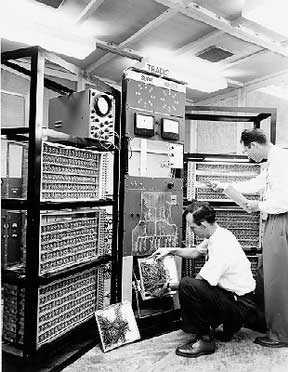First Generation of Computer: Vacuum TubesThe vacuum tubes technology was used by the first generation of the computers, which was invented by Lee De Forest in 1906. The vacuum tube inventor named Lee De Forest, was an electrical engineer. For the memory and taking up the big rooms, the vacuum tubes were used on the first generation of a computer for the magnetic drums and the circuitry. It produced a large amount of heat and was very costly to operate; also, it consumed high electricity. During the first half of the 20th century, the vacuum tube was generally used to build a wide variety of other electronic devices, including televisions, radar, radios, and X-ray machines, as it was the fundamental technology. Additionally, this technology was also used with the computers made in the first generation. The below picture is an example of vacuum tubes. 
The first generation of the computer was dependent upon the lowest-level programming language known as machine language, which was used by the computer (first-generation) to perform different kinds of operations. This was not able to perform multitasking work and capable of solving only one problem at a time. The ENIAC was the first operational electronic general-purpose computer, which stands for Electronic Numerical Integrator and Computer. In ENIAC, 18000 vacuum tubes were used to build it in 1943. And, it was built at the University of Pennsylvania's Moore School of Engineering with government funds. The primary credit goes to John W. Mauchly (1907-1980) and J. Presper Eckert, Jr. (1919-1995) in order to design of the ENIAC (Electronic Numerical Integrator and Computer). For temporary calculations, it contained twenty 10-digit registers, and its size was around 30.5 meters (100 feet) long. The ENIAC was programmed with plugboard wiring. It used punch cards and paper tape to take input and produce output. It was not faster in terms of speed as could compute at the rate of 1,900 additions per second. The main use of the ENIAC was in the war-related computations, such as it helped in the building of the atomic bomb in terms of calculations, and in the constructing of ballistic firing tables. Additionally, the Colossus (British machine) was built during these years, it was another machine to help fight World War II. It had the ability to decode confidential enemy messages. Like the ENIAC, it was programmed using plugboard wiring, and it used 1500 vacuum tubes. Typically, these older machines were controlled with the help of a series of directions encoded on paper tape or by plugboard wiring. Some computations needed one wiring, and other computations required another. Therefore, the programs of these machines were not stored internally while these were clearly programmable. The concept of the stored-program was recognized by the team working on the ENIAC for the first time. John von Neumann (1903-1957), John W. Mauchly (1907-1980) and J. Presper Eckert Jr. (1919-1955) were involved at the time of developing this concept. During the summer of 1946 at the Moore School, a seminar was held that had basic attention on the concept of the design of a stored-program computer. Also, this seminar was attended by almost 30 scientists from both sides of the Atlantic Ocean and soon stored programmed machines were built by them. A British team was made by Maurice Wilkes (1913-). Maurice Wilkes was one of the attendees at the Moore School seminar. In 1949, this team built the EDSAC at Cambridge; EDSAC stands for Electronic Delay Storage Automatic Calculator. Later, EDVAC (Electronic Discrete Variable Automatic Computer) was completed by the team made by Richard Snyder at the Moore School. In 1952, IAS (Institute for Advanced Study) machine was built by Von Neumann at Princeton University. These machines still were built by using vacuum tubes that led to the store their program internally. UNIVAC stands for Universal Automatic Computer was another stored program machine of the first generation. Mauchly and Eckert designed this computer, and it was the first successful commercial computer delivered to a business client. For bulk storage, it employed magnetic tape. It was designed by using over 5,000 vacuum tubes. In tasks like election prediction, actuarial table computation, and accounting, it was commonly used. The first program of UNIVAC was running in 1949. As compared to ENIAC, it had the ability to execute ten times in terms of multiple additions per second as the ENIAC. The price of UNIVAC was at $4,996,000 in modern dollars. Furthermore, the first computer was shipped by IBM during this period. Some other examples of the first generation of computer included: EDVAC, IBM-650, and IBM-701. 
Origins and Early DaysThe genesis of first-generation computers can be traced back to the efforts of brilliant minds like Alan Turing, John von Neumann, and others who conceptualized the idea of a programmable digital computer. The motivation for these endeavours was to create machines that could automate complex calculations. The very first computer, the Electronic Numerical Integrator and Computer (ENIAC), came in 1945 at the University of Pennsylvania. ENIAC changed into a wonder of its time, occupying a whole room along with over 17,000 vacuum tubes. Its purpose changed to performing calculations for artillery trajectory tables at some unspecified time in the future of World War II. Although groundbreaking, ENIAC had barriers at the side of the need for substantial manual reprogramming. Architecture and ComponentsFirst-generation computers were characterized by their unique shape, ruled through vacuum tubes as the fundamental building blocks. Vacuum tubes served as digital switches, manipulating electric signs to represent binary statistics. These tubes generated a considerable amount of heat, requiring huge cooling systems and making the computer systems large, bulky, and vulnerable to common malfunctions. The structure of these computer systems is often based totally on the von Neumann shape, named after John von Neumann, a mathematician and computer scientist. This structure featured a central processing unit (CPU), memory, and input/output devices. The commands and information had been saved inside the same memory unit, a format principle that has persevered in the next computer generations. Programming ChallengesProgramming first-generation computer systems were modified into an impressive project, as there had been no specific programming languages just like the ones we are familiar with in recent times. Instead, programmers needed to use high-level language or assembly language, coding suitable for the binary system of 0s and 1s. This system became demanding and time-consuming, requiring a deep knowledge of the computer's structure. Grace Hopper, a pioneering computer scientist, performed an essential characteristic in growing the primary compiler, a software that translates complex programming languages into machine code. Her artwork inspired future generations of computers, making programming handier and more efficient. Advancements and MilestonesDespite their barriers, first-generation computers achieved extremely adequate milestones. The UNIVAC I (Universal Automatic Computer I), designed with the resources of J. Presper Eckert and John Mauchly, has grown to be the primary commercially produced computer and has been used for plenty of programs, collectively with commercial business statistics processing and clinical calculations. The improvement of magnetic tape and magnetic disk storage systems marked a huge development in information storage. These innovations allowed for the storage and retrieval of huge amounts of records, contributing to the enlargement of computer programs beyond scientific and navy domain names. Advantage and disadvantage of the first generation of computerThe first generation of computers possessed characters that made this generation different from other generations of computers. Although the first generation of computers was helpful during the war times, the features of computers of first generation were incapable. For instance, all computers made in the first generation were not able to calculate a large amount of data, and they were slow in terms of speed. It has been discussed by George Dyson that the technology vacuum tubes used in the first generation of computers were very parochial and an inefficient technique; therefore, this generation of computers had some of the features. On the use of computers made in the first generation, the features of the computers pf first generation had a general impact. Because as compared to the advantages it carried, it brought various limitations. For instance, due to the fact that the size of the computers, one of the limitations of using the first generation of computers was unreliable. Because when they were used, they were produced an enormous amount of heat every time. That means an air conditioner was needed by the first generation of computer users on the computer. This is because the air conditioner keeps the computer's operating system cool down that led to work effectively. Additionally, they reduced the input and output devices as they were unreliable, which made it very time consuming to use always. Also, because of the technology and size of the computers, they were very expensive, that means that only big and established organization were able to purchase them. Below is given a table that contains all points of the advantages and disadvantages of the first generation of computers:
Challenges and LimitationsThe demanding situations faced by first-generation computer systems have been severe. The dependence on vacuum tubes triggered troubles, together with frequent screw-ups and immoderate energy consumption. The computer systems generated an extensive amount of heat, requiring brand-new cooling systems to save from overheating. Additionally, the machines were expensive to construct and preserve, restricting their accessibility. The concept of real-time processing came to be a dream during this period. These early computer systems were not able to multitask, and their processing speeds were a fragment of what modern-day computer structures obtain. The obstacles of first-generation computer structures underscored the need for similar improvements to address those disturbing conditions.
Next TopicSecond Generation of Computer
|
 For Videos Join Our Youtube Channel: Join Now
For Videos Join Our Youtube Channel: Join Now
Feedback
- Send your Feedback to [email protected]
Help Others, Please Share










